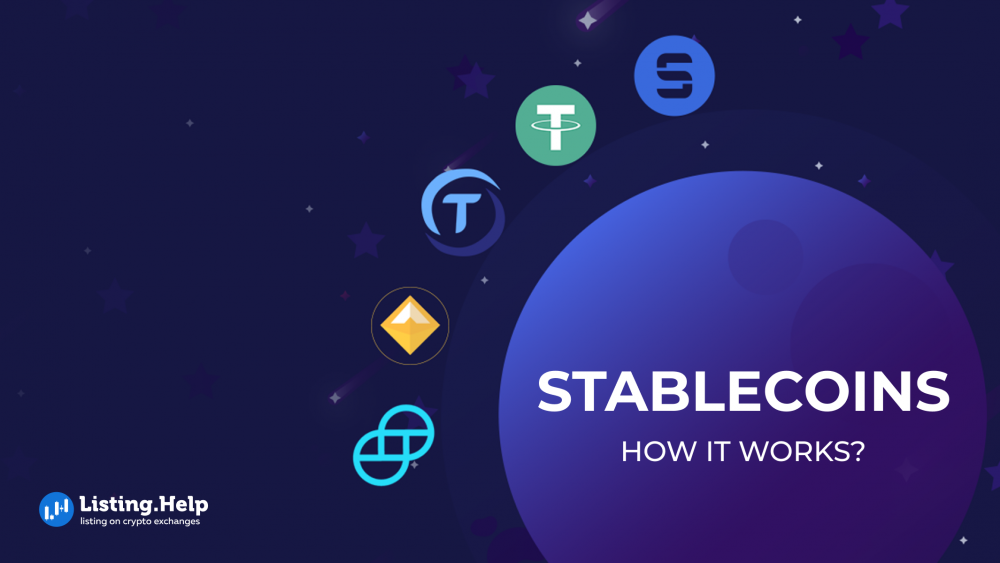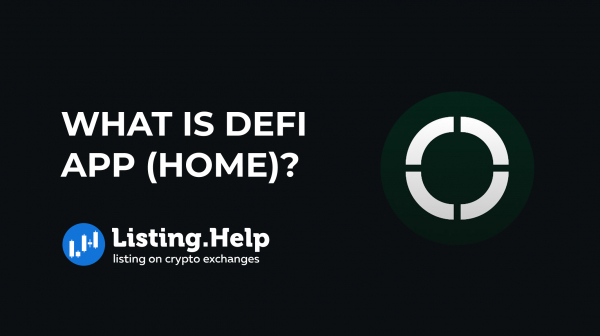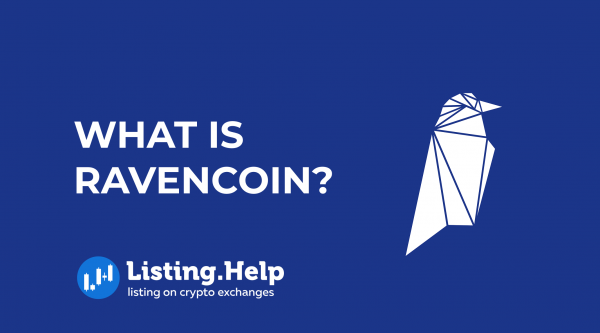What Are Stablecoins? Stablecoins Types.
 October 19, 2023
October 19, 2023 Updated: October 19 2023, 12:44
Updated: October 19 2023, 12:44
LEAVE A REQUEST
Launching your own token project? Our experts are ready to help with listing on exchanges, market making, marketing and other solutions
SUBMIT APPLICATIONEven if you haven’t put your money into it, you’ve likely heard about ‘blockchain’ and ‘cryptocurrency.’ These digital monies have been on a wild ride for over ten years, sometimes zooming in value and other times crashing down, which can be kind of nerve-wracking to watch.
But hey, if you’re looking for something in the crypto space that’s a bit safer, let me tell you about stablecoin.
Simply put, a stablecoin is a kind of cryptocurrency that doesn’t jump around in price. It stays steady because its value is hooked, or “pegged,” to something stable, like gold or conventional money like dollars and euros. It’s like having a kind of money shield in the sometimes chaotic world of crypto.
How do Stablecoins Work?
Stablecoins do their thing by using blockchain technology. They’re used for buying stuff, counting value, and keeping value, all while being a kind of payment token.
Some big-name stablecoins you might have heard of include Tether (USDT), Dai (DAI), and USD Coin (USDC), to name a few.
While some regular (fiat) money can lose value thanks to inflation, and others like Bitcoin (BTC) and Ethereum (ETH) can have wild price swings, stablecoins are the steady hands in the market, keeping their value even and cool, helping to keep the wobbly crypto markets a bit more steady.
What sets stablecoins apart are a few key perks and features that make them different from both the up-and-down world of cryptocurrencies and traditional money:
- Stability: Stablecoins, true to their name, hold onto their value, providing a safe, stable option amidst the often turbulent crypto waters. This steadiness allows users to breathe easy, minimizing the usual rollercoaster ride seen with crypto prices.
- Transparency: Many stablecoins work on public blockchains, meaning anyone can check out their transaction histories. That openness helps build trust and ensures everyone plays fair in the stablecoin world.
- Quick and Cheap: Transactions using stablecoins are not only super fast but also won’t break the bank compared to traditional banking systems or sending money internationally. This quick, low-cost way of moving money is a big win for those wanting speedy, wallet-friendly financial dealings.
- Easy Access: If you’ve got an internet connection, you can use stablecoins, giving power to people in areas where traditional banking might not reach. This allows folks to do things like send money, save, and more, all without needing a regular bank account.
- Compatibility: Stablecoins get along well with other crypto tools and platforms, such as wallets, exchanges, and decentralized apps. This ease of use means users can make the most of stablecoins across a range of uses in the wider crypto world.
What Are the Main Types of Stablecoins?
Stablecoins, while all aiming for stability, achieve it in various ways. Let’s dig into the main four kinds.
1. Fiat-backed stablecoins
This type is backed by a regular, government-made currency like the USD or the pound. To get one digital coin, you need to provide the same amount of regular money as backup or collateral.
Think of fiat-collateralized stablecoins as having a 1-to-1 value with the regular currency they’re backed by. They’re currently the top dogs in the cryptocurrency space in terms of popularity and use.
Imagine you’re using the USD. One stablecoin would always be equal in value to one dollar. A clear example: with Tether (USDT), 1 USDT is always worth 1 USD.
But a word of caution: since these coins are issued by centralized groups and they set their rules and protocols, fraud isn’t impossible. So, it’s crucial to stick with issuers you believe in.
2. Commodity-backed stablecoins
Commodity-collateralized stablecoins stand out in the digital currency space by being backed by physical assets like gold, silver, oil, or exclusive real estate instead of fiat currency. These assets have a historical reputation for being safe stores of value, providing a tangible backstop for the stablecoin’s value.
However, the commodities anchoring them are not immune to market fluctuations, being influenced by diverse economic and geopolitical factors. Additionally, the secure storage and authenticity verification of these assets are crucial to sustaining trust and stability within the stablecoin ecosystem.
3. Cryptocurrency-backed stablecoins
When we delve into cryptocurrency-collateralized stablecoins, we are engaging with a type of stablecoin that is underpinned by other cryptocurrencies. By employing cryptocurrencies as the safety net, the whole operation is inherently decentralized and conducted on the blockchain. Often, you’ll find that the ratio is set around 1:2.
Given that a cryptocurrency serves as the foundational asset, it brings with it a level of risk and susceptibility to volatility that is notably higher than traditional secure assets. To keep the stablecoin’s supply stable and immune to abrupt price shifts – a characteristic not uncommon in the cryptocurrency market – an ample amount of cryptocurrencies must be locked in as collateral against each stablecoin issued.
This substantial reserve is often labeled “over-collateralized” due to the hefty amount held back to safeguard the stablecoin’s stability. One can look at Dai (DAI), which is secured by collateral on the Maker platform, as a pertinent example.
This type of stablecoin, with its intricate relationship with cryptocurrencies, tends to trail behind its fiat-backed peers in terms of popularity and usage due to its inherent complexities and potential risks.
4. Algorithmic stablecoins
Engaging with the concept of algorithmic stablecoins, we’re met with a particular kind of digital currency where neither traditional fiat nor another cryptocurrency stands as its backing, hence the designation of being non-collateralized. In the absence of a reserve asset to tether its value, the stability of these stablecoins is instead orchestrated by a specific algorithm.
The maintenance of price stability within these stablecoins is directed by smart contracts, which autonomously manage supply and demand. When the stablecoin trades above its peg, the algorithmic function triggers the creation of new coins, while alternatively, if the value dips, the system will strategically purchase coins to reduce its available supply in the market.
Take, for example, Primecoin (XPM), or the cryptocurrency base coin, which leverages a consensus mechanism to aptly modulate whether to augment or diminish the supply of tokens as per prevailing market conditions.
Even though algorithmic stablecoins might initially appear to be a complex variant among their peers, their operational logic mirrors traditional processes utilized by central banks in managing currency supply, albeit within a decentralized context.
Stablecoins: A Functional Overview
Stablecoins, amidst the financial turbulence often associated with cryptocurrencies, stand out by ensuring streamlined international transactions and acting as a consistent store of value. Their role is pivotal in decentralized finance (DeFi), enhancing mechanisms such as lending, and acting as a currency within the cryptocurrency environment.
Additionally, stablecoins open the doors to financial participation for those who find traditional banking services out of reach, enabling them to partake in digital financial activities. They also facilitate the tokenization of physical assets, which can alleviate liquidity issues and offer fractional ownership, particularly in sectors like real estate and commodities.
Use Cases:
- Medium of Exchange: With their stability, stablecoins provide a reliable mechanism for conducting transactions and peer-to-peer transfers.
- Value Preservation: Stablecoins can be retained as a safeguard against the volatile nature of other cryptocurrencies and market fluctuations.
- Supporting Decentralized Finance: In the DeFi space, stablecoins function as a steady accounting unit, collateral, and liquidity source, interacting with various platforms and protocols.
- Enabling International Payments: Utilizing blockchain, stablecoins eliminate the need for conventional intermediaries in international transactions, cutting down on fees and transaction times.
- Promoting Financial Inclusion: They afford those in areas with restricted access to conventional financial systems the ability to actively participate in global economic activities.
- Streamlining Remittances: For international money transfers, stablecoins present a fast, secure, and economical option.
- Stability in Volatile Markets: During unstable market conditions, traders can maintain their portfolio value by converting their holdings into stablecoins without resorting to fiat currencies.
Conclusion
When dealing with stablecoins, it’s vital to take your time. Making smart choices with your money means doing your research and moving carefully. Acting too quickly or without the right information can lead you down the wrong path in your financial activities.

For more insights and information on stablecoins and other cryptocurrency topics, visit our blog at https://listing.help/blog. We provide straightforward and easy-to-understand information to assist you in making informed decisions in the digital finance world.







 July 2, 2025
July 2, 2025 








